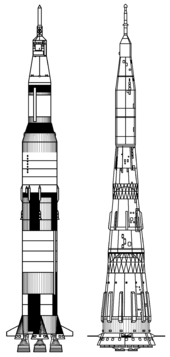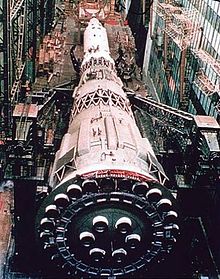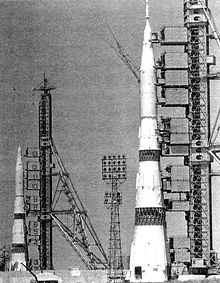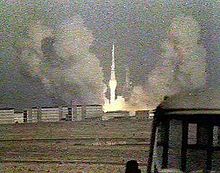- N1 (rocket)
-
This article is about the Soviet rocket. For the Japanese rocket, see N-I rocket
N1 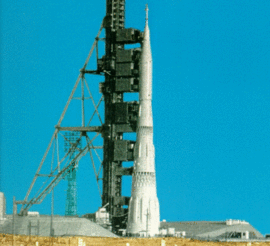
N1-L3 rocket on the launchpad at Baikonur CosmodromeFunction Manned lunar carrier rocket Manufacturer OKB-1 Country of origin USSR Size Height 105 metres (344 ft) Diameter 17.0 metres (55.8 ft) Mass 2,735,000 kilograms (6,030,000 lb) Stages 5 Capacity Payload to
LEO90,000 kg (200,000 lb) Payload to
TLI23,500 kg (52,000 lb) Launch history Status Retired Launch sites LC-110, Baikonur Total launches 4 Successes 0 Failures 4 Maiden flight 21 February 1969 Last flight 23 November 1972 First Stage - Block A Diameter 17.0 m (55.8 ft) Engines 30 NK-15 Thrust 50,300 kN (11,300,000 lbf) Specific impulse 3.24 kN·s/kg (330 s) Burn time 125 s Fuel RP-1/LOX Second Stage - Block B Engines 8 NK-15V Thrust 14,040 kN (3,160,000 lbf) Specific impulse 3.39 kN·s/kg (346 s) Burn time 120 s Fuel RP-1/LOX Third Stage - Block V Engines 4 NK-21 Thrust 1,610 kilonewtons (360,000 lbf) Specific impulse 3.46 kN·s/kg (353 s) Burn time 370 seconds Fuel RP-1/LOX Fourth Stage (N1/L3) - Block G (Earth departure) Engines 1 NK-19 Thrust 446.00 kN (100,260 lbf) Specific impulse 3.46 kN·s/kg (353 s) Burn time 443 s Fuel RP-1/LOX N-1 was a heavy lift rocket intended to deliver payloads beyond low Earth orbit, acting as the Soviet counterpart to the NASA Saturn V rocket.[1][2] This heavy lift booster had the capability of lifting very heavy loads into orbit, designed with manned extra-orbital travel in mind. Development work started on the N-1 in 1959.[2]
The N1-L3 version was developed to compete with the United States Apollo Saturn V to land a man on the Moon. The basic N1 launch vehicle had three stages, which carried the L3 lunar payload into Low Earth orbit. The L3 contained an Earth departure stage and a lunar landing assist stage, in addition to the single-cosmonaut LK Lander spacecraft, and a two-cosmonaut Soyuz 7K-L3 lunar orbital spacecraft.
N1-L3 was underfunded, undertested, and started development in October 1965, almost four years after the Saturn V. The project got badly derailed by the death of its chief designer Sergei Korolev in 1966. After four failed launch attempts, the program was suspended in 1974, and in 1976 was officially cancelled. The N1 program (along with the rest of the Soviet manned moon programs) was kept secret almost until the collapse of the Soviet Union in December 1991; information about the N1 was first published in 1989.
Contents
History
Early work
Development began under the direction of Sergei Korolev at his OKB-1 Design Bureau. The original design proposed a 50-metric-ton (110,000 lb) payload[3] intended as a launcher for military space stations and a manned Mars flyby using a nuclear engine upper stage. The N1 was the largest of three proposed designs; the N2 was somewhat smaller and intended to compete with Vladimir Chelomei's proposed UR-200, and the much smaller N3, which would replace Korolev's "workhorse" R-7 rocket. At this point the N-series was strictly a "paper project".
In December 1959 a meeting was called with all of the chief designers, who presented their latest designs to the military. Korolev presented the N-series along with a much more modest series of upgrades to the R-7. Vladimir Chelomei, Korolev's rival, presented his "Universal Rocket" series, which used a common lower stage in various clustered configurations to meet a wide variety of payload requirements. Mikhail Yangel, perhaps the most successful of the three but with little political power, presented the small R-26 intended to replace the R-16, the much larger R-36 ICBM, as well as the SK-100, a space launcher based on a huge cluster of R-16's. In the end the military planners selected Chelomei's UR-100 as the new "light" ICBM, and Yangel's R-36 for the "heavy" role. They saw no need for any of the larger dedicated launchers, but also gave Korolev funding to develop the Molniya (8K78) adaptation of the R-7.
In March 1961, during a meeting at Baikonur, designers discussed the N1 design, along with a competing Glushko design, the R-20. In June, Korolev was given a small amount of funding for N1 development between 1961 and 1963. In May 1961 a government report, On Reconsideration of the Plans for Space Vehicles in the Direction of Defense Purposes, set the first test launch of the N1 rocket for 1965.
Moon missions
When the US announced the goal of landing a man on the Moon in May 1961, Korolev proposed a lunar mission based on a new spacecraft, eventually known as Soyuz, that was designed for Earth orbit rendezvous. Several launches would be used to build up a complete moon package, one for the Soyuz, another for the lunar lander, and additional launches with cislunar engines and fuel. This approach makes the least demands on the launch vehicle, as the payload mass is reduced for any one launch. This is at the expense of requiring a rapid launch rate to ensure that the modules are built up before running out of consumables while waiting on-orbit. Even using this profile the lunar boosters and fuel were too large for any existing Soviet launcher. Korolev thus proposed development of the N1 with a 50 t (110,000 lb) payload – much smaller than the N1 design that would eventually be delivered.
To power the new design, Valentin Glushko, who then held a near-monopoly on rocket engine design in the Soviet Union, proposed a new engine, the RD-270, running on unsymmetrical dimethylhydrazine (UDMH) and nitrogen tetroxide (N2O4). This formula is hypergolic (i.e. its components ignite on contact, reducing the complexity of the combustion system), and was widely used in Glushko's existing engine designs used on various ICBMs. The propellant pair UDMH/N2O4 has a lower specific impulse than kerosene/liquid oxygen,however because the RD-270 uses the much more efficient Full flow staged combustion cycle as opposed to the simple gas generator cycle used on the American F-1 rocket engine the specific impulse of RD-270 was higher than the comparable American F-1. Korolev also felt that the toxic nature of the fuels and their exhaust presented a safety risk for manned space flight.However Glushko pointed out that the US titan rockets used to launch Gemini spacecraft also used identical propellants so these concerns were unwarranted.What is more given the fact that the Americans had a 5 year head start with the American F-1 engine development and still facing combustion stability problems it was unrealistic to expect him to miraculously virtually overnight deliver a similar engine with practically no money,primitive computer technology and a very inferior kersosene fuel prone to coking at high temperatures as opposed to the rocket grade fuel used in the Saturn V.There were strong personal resentments between the two, Korolev holding Glushko responsible for his near death at Kolyma Gulag and failure of his first marriage as a result and Glushko considering Korolev to be irresponsibly cavalier and autocratic in his attitudes towards things outside his competence in this case rocket engines and refused outright to work on LOX/Kerosene engines and Korolev in general.He instead teamed up with other rocket designers to build the very successful Proton rocket.Later he did build a LOX/Kerosene engine even more powerful and advanced than the F-1 known as the RD-170 however its development took over ten years despite it being 20 years after the American F-1 due to the relative backwardness of the USSR's industrial base as foreseen by Glushko and thus probably vindicated his decision not to support the development of such an engine for the N-1 rocket.
The difference of opinions led to a falling out between Korolev and Glushko. In 1962 a committee that was appointed to break the logjam agreed with Korolev. Since Glushko refused to work on such a design, Korolev eventually "gave up" and decided to enlist the help of Nikolai Kuznetsov, the OKB-276 jet engine designer. Kuznetsov, who had limited experience in rocket design, responded with a fairly small engine known as the NK-15, which would be delivered in several versions tuned to different altitudes. To achieve the required amount of thrust, it was proposed that a large number of NK-15s would be used in a clustered configuration around the outer rim of the lower-stage booster. The "inside" of the ring of engines would be open, with air piped into the hole via inlets near the top of the booster stage. The air would be mixed with the exhaust in order to provide thrust augmentation, as well as additional combustion with the deliberately fuel-rich exhaust. The ring-like arrangement of so many rocket engine nozzles on the N1's first stage could have been an attempt at creating a crude version of a toroidal aerospike engine system; more conventional aerospike engines were also studied.
Meanwhile, Chelomei's OKB-52 proposed an alternate mission with much lower risk. Instead of a manned landing, Chelomei proposed a series of circumlunar missions which he felt would be able to beat the US. He also proposed a new booster for the mission, clustering three of his existing UR-200 designs (known as the SS-10 in the west) to produce a single larger booster, the UR-500. However, these plans were dropped when Glushko offered Chelomei the RD-270, which allowed the construction of a much simpler "monoblock" design, also known as the UR-500. He also proposed adapting an existing spacecraft design for the circumlunar mission, the single-cosmonaut LK-1. Chelomei felt that improvements in early UR-500/LK-1 missions would allow the spacecraft to be adapted for two cosmonauts.
The Soviet military, specifically the Strategic Missile Forces, was reluctant to support what was essentially a politically-motivated project with little military utility, but both Korolev and Chelomei pushed for a lunar mission. For some time, between 1961 and 1964, Chelomei's less aggressive proposal was accepted, and development of his UR-500 and the LK-1 were given a high priority.
Space race
Main article: Space RaceSince the US Project Gemini reversed the Soviet lead in human space exploration by 1966, Korolev was able to persuade Leonid Brezhnev to let him pursue his plans to make a lunar landing before the US.[citation needed] Since there were a number of unknowns in the Earth orbit rendezvous profile that could not be tested in time, a direct ascent profile similar to Apollo was selected. This required much larger boosters.
Korolev proposed a larger N1, combined with a new lunar package known as the L3. The L3 combined the lunar engines, an adapted Soyuz spacecraft (the LOK) and the new LK lunar lander in a single package. Chelomei responded with a clustered UR-500-derived vehicle, topped with the L1 spacecraft already under development, and a lander of their own design. Korolev's proposal was selected as the winner in August 1964, while Chelomei was told to continue with his circumlunar UR-500/L1 work.
When Khrushchev was overthrown later in 1964, infighting between the two teams started anew. In October 1965 the Soviet government ordered a compromise; the circumlunar mission would be launched on Chelomei's UR-500 using Korolev's Soyuz spacecraft in place of their own Zond design, aiming for a launch in 1967, the 50th anniversary of the Bolshevik Revolution. Korolev, meanwhile, would continue with his original N1-L3 proposal. Korolev had clearly won the argument, but work on the L1 continued anyway, as well as the Zond.
Korolev died in 1966 due to complications after minor surgery, and the work was taken over by his deputy, Vasily Mishin. Mishin did not have Korolev's political astuteness or power, a problem that led to the eventual downfall of the N1, and of the lunar mission as a whole.
Description
The N1 was a very large rocket, standing 105 metres (344 ft) tall—among the world's largest launch vehicles, somewhat smaller than the Saturn V in height and mass, but greater in lift-off thrust, but with significantly less payload capability. The N1-L3 consisted of five stages in total, three for immediate boost into orbit (the N1), and another two for the lunar portion (the L3). Fully loaded and fueled, the N1-L3 weighed 2,788 metric tons (6,150,000 lb). The lower three stages were shaped to produce a single truncated cone just over 10 m wide at the base, while the L3 section was cylindrical at about 4.4 m wide. The conical shaping of the lower stages was due to the arrangement of the tanks within, a smaller spherical kerosene tank on top of the larger liquid oxygen tank below.
The first stage, Block A, was powered by 30 NK-15 engines arranged in two rings, the main ring of 24 at the outer edge of the booster, the inner of 6 at about half diameter. The engines were the first ever staged combustion cycle engines. The control system was primarily based on differential throttling of the engines, the outer ring for pitch and yaw, the inner six on gimballing mounts for roll. The Block A also included four grid fins, which were later used on Soviet air-to-air missile designs. In total, the Block A produced 43 meganewtons (9,700,000 lbf)[4] of thrust. This exceeded the 33.7 meganewtons (7,600,000 lbf)[5] thrust of the Saturn V.
The second stage, Block B, was powered by 8 NK-15V engines arranged in a single ring. The only major difference between the NK-15 and -15V was the engine bell and various tunings for air-start and high-altitude performance. The upper stage, Block V (V being the third letter in the Russian alphabet), mounted four smaller NK-21 engines in a square.
During the N1's lifetime, a series of improved engines was introduced to replace those used in the original design. The first stage used an adaptation of the NK-15 known as the NK-33, the second stage a similar modification known as the NK-43, and finally the third stage used the NK-31. The resulting modified N1 was known as the N1F, but did not fly before the project's cancellation.
In comparison with the American Saturn V, the N1 is slightly shorter, more slender overall, but wider at the base. Generally the N1 produced much more thrust than the Saturn V. It used only kerosene fuel in all three of its stages, and had somewhat lesser overall performance than the Saturn; the N1 stack was intended to place about 90 metric tons (200,000 lb) of payload into Low Earth orbit, whereas the Saturn V could orbit about 119 tonnes (131 short tons). The US's experience with higher energy liquid hydrogen as fuel gave them the confidence to use it on the Saturn upper stages, which significantly reduced the upper stages' take-off weight and increased the payload fraction. The Saturn V also had a superior reliability record: it never lost a payload in 13 operational launches, while four N1 launch attempts all resulted in failure, with two payload losses.
The US spent more money[citation needed] developing the Saturn V. Development of the Saturn V also began almost four years sooner, in January of 1962.
Problems
Complex plumbing was needed to feed fuel and oxidizer into the clustered arrangement of rocket engines. This proved to be extremely fragile, and was a major factor in the design's launch failures. Furthermore the N1's Baikonur launch complex could not be reached by heavy barge. To allow transport by rail, all the stages had to be broken down and re-assembled. As a result, the complex and destructive vibrational modes (which ripped apart propellant lines and turbines) as well as exhaust plume fluid dynamic problems (causing vehicle roll, vacuum cavitation, and other problems) were not discovered and worked out before flight.
As a result of its technical difficulties, in turn due to lack of funding for full-up testing, the N1 never successfully completed a test flight. All four unmanned launches out of 12 planned tests ended in failure, each before first-stage separation. The longest flight lasted 107 seconds, just before 1st stage separation. Two test launches occurred in 1969, one in 1971 and the final one in 1972.
Mishin continued with the N1F project after the cancellation of plans for a manned moon landing in the hope that the booster would be used to launch a large space station comparable to the US Skylab. The program was terminated in 1974 when Mishin was replaced by Glushko. Two N1Fs were being readied for launch at the time, but these plans were cancelled.
The program was followed by the "Vulkan" concept for a huge Proton-like hypergolic-fueled vehicle, and then in 1976 by the commencement of the Energia/Buran program.
N1 vehicles
- N1 1M1 - Static test model, two first stages painted gray, third stage gray-white and L3 white.
- N1 1L and 2L - test vehicles
- N1 3L - first launch attempt, engine fire, exploded at 12 km
- N1 4L - never launched, parts used for other launchers
- N1 5L - partially painted gray; early launch failure destroyed pad
- N1 6L - launched from the second pad 110, deficient roll control, destroyed at 1 km
- N1 7L - all white, last launch attempt; pogo failure, cutoff at 40 km
- N1 8L, 9L and 10L
Remains
The two flight-ready N1Fs were scrapped and their remains could still be found around Baikonur years later used as shelters and storage sheds. The boosters were deliberately broken up in an effort to cover up the USSR's failed moon attempts, which was publicly stated to be a paper project in order to fool the US into thinking there was a race going on. This cover story lasted until glasnost, when the remaining hardware was seen publicly on display.
The advanced engines for the N1F escaped destruction. Although the rocket as a whole was unreliable, the NK-33 and NK-43 engines are considered rugged and reliable when used as a standalone unit. About 150 engines survived, and in the mid-1990s, Russia sold 36 engines to Aerojet General for $1.1 million each. This company also acquired a license for the production of new engines.
Supplied through Aerojet, three of the engines were incorporated into Japanese rockets J-1 and J-2. The US company Kistler Aerospace worked on incorporating these engines into a new rocket design, with which Kistler sought to eventually offer commercial launch services, before declaring bankruptcy. In Russia, N1 engines were not used again until 2004, when the remaining 70 or so engines were incorporated into a new rocket design. As of 2005[update], the project has been frozen due to the lack of funding. The current design of Orbital Science's Taurus II launch vehicle includes two NK-33s as the first stage engines.
Launch history
- February 21, 1969 – Vehicle serial number 3L – Due to unexpected high-frequency oscillations in the gas generator, one of the pipes broke apart and a fire started. This fire reached the engine control system which at the 68.7 s of flight sent the command to shut down the engines.[6] The rocket exploded at 12,200 m altitude, 69 seconds after liftoff. The emergency rescue system was activated and did its job properly, saving the mockup of the spacecraft. All subsequent flights had freon fire extinguishers installed next to every engine.[7]
- July 3, 1969 – Vehicle serial number 5L – At liftoff a loose bolt was ingested into a fuel pump, which failed. After detecting the inoperative fuel pump, the automatic engine control shut off 29 of 30 engines, which caused the rocket to stall. The rocket exploded 23 seconds after shutting off the engines, destroying the rocket and launch tower in the biggest explosion in the history of rocketry[8][9] and also the largest manmade non-nuclear explosion ever (nearly 7 kilotons of TNT equivalent.)[citation needed] The destroyed complex was photographed by American satellites, disclosing that the Soviet Union was building a Moon rocket.[7] The rescue system saved the dummy spacecraft again. After this flight, fuel filters were installed in later models.[7]
- June 26, 1971 – Vehicle serial number 6L – experienced an uncontrolled roll immediately after liftoff beyond the capability of the control system to compensate; the vehicle was destroyed 51 seconds after liftoff at 1 km altitude. This vehicle had dummy upper stages without the rescue system. The next, last vehicle had much more powerful stabilization system with dedicated engines (in the previous versions stabilization was done by directing exhaust from the main engines). The engine control system was also reworked, increasing the number of sensors from 700 to 13,000.[7]
- November 23, 1972 – Vehicle serial number 7L – the engines ran for 106.93 seconds after which pogo oscillation of the first stage caused engine cutoff (a problem which also plagued the engineers of the US Saturn V) at 40 km altitude; a programmed shutdown of some of the engines to prevent over-stressing of the structure led to an explosion of the oxygen pump on the engine number 4.[7] The vehicle disintegrated.
Confusion on L3 designation
There is a great deal of confusion among Russian online sources as to whether N1-L3 (Russian: Н1-Л3) or N1-LZ (Russian: Н1-ЛЗ) was intended, because of the similarity of the Cyrillic letter Ze for "Z" and the number "3". Sometimes both forms are used within the same Russian website (or even the same article).[6][10] English sources refer only to N1-L3. It is clear from the writing of a leading project designer that the correct designation is L3, representing the third stage of Soviet lunar exploration. Stage 1 would be an unmanned circumlunar flight; stage two would be a manned circumlunar flight, and stage 3 would be the manned landing.[11]
See also
- Comparison of super heavy lift launch systems
- Soviet Moonshot
- Nova rocket
- Ares V
References
- ^ "N1". Encyclopedia Astronautica. http://www.astronautix.com/lvs/n1.htm. Retrieved 2011-09-07.
- ^ a b "The N-1 Moon Rocket - a brief History". http://www.starbase1.co.uk/n1/n1-history.html. Retrieved 2011-09-07.
- ^ Lindroos, Marcus. THE SOVIET MANNED LUNAR PROGRAM MIT. Accessed: 4 October 2011.
- ^ Wade, Mark (1997-2008). "N1". Encyclopedia Astronautica. http://www.astronautix.com/lvs/n1.htm. Retrieved 2009-04-25.
- ^ Wade, Mark (1997-2008). "Saturn V". Encyclopedia Astronautica. http://www.astronautix.com/lvs/saturnv.htm. Retrieved 2009-04-25.
- ^ a b "Buran". http://www.buran.ru/htm/gud%2019.htm.
- ^ a b c d e "Die russische Mondrakete N-1 (in German)". http://www.bernd-leitenberger.de/hercules.shtml.
- ^ "BBC – Space Race"
- ^ YouTube N1 soviet moon rocket / N1-5L Launch http://www.youtube.com/watch?v=CLHIrKE2HqQ
- ^ "Novosti-Kosmonavtiki". http://www.novosti-kosmonavtiki.ru/content/numbers/240/21.shtml.
- ^ В. М. Филин (V.M. Filin), Воспоминания О Лунном Корабле (Memories of the Moon Ship), Издательство "Культура" (publisher "Culture"), 1992, pg. 5
External links
- Astronautix history of the N-1
- N-1 Launch Vehicle
- Statistics and information. Interactive model.
- Video footage of an N-1 exploding in flight
- Raketno-kosmicheskii kompleks N1-L3 (in Russian)
- Interview with Vasily Pavlovich Mishin (in Russian)
- Kistler Aerospace Corporation – the U.S. company developing an NK-33 based rocket
- drawing
Soviet, Russian and Ukrainian expendable launch vehicles Active In development Former Expendable launch systems Current Ariane 5 · Atlas V · Delta (II · IV) · Dnepr-1 · GSLV · H-IIA · H-IIB · Kaituozhe-1 · Kosmos-3M · Long March (1D · 2C · 2D · 2F · 3A · 3B · 3C · 4B · 4C) · Minotaur (I · IV) · Naro-1 · Paektusan · Pegasus · Proton (K · M) · PSLV · Rokot · Safir · Shavit · Shtil' · Start-1 · Strela · Soyuz (U · FG · 2) · Taurus · Unha · VLS-1 · Volna · Zenit (2 · 2M · 3SL · 3SLB)
Planned Angara · Athena (Ic · IIc) · GSLV III · Haas · Long March (5 · 6 · 7) · Minotaur V · RPS-420 · Rus-M · Soyuz-1 · Simorgh · TSLV · Taurus II · Tsyklon-4 · Vega · Zenit-3F
Previous Ariane (1 · 2 · 3 · 4) · ASLV · Athena (I · II) · Atlas (B · D · E/F · G · H · I · II · III · LV-3B · SLV-3 · Able · Agena · Centaur) · Black Arrow · Caleb · Conestoga · Delta (A · B · C · D · E · G · J · L · M · N · 0100 · 1000 · 2000 · 3000 · 4000 · 5000 · III) · Diamant · Energia · Europa · Falcon 1* · Feng Bao 1 · H-I · H-II · J-I · Juno I · Juno II · Kosmos (1 · 2I · 3) · Lambda (4S) · Long March (1 · 2A · 2E · 3 · 4A) · Mu (4S · 3C · 3H · 3S · 3SII · V) · N1 · N-I · N-II · Pilot · R-7 (Luna · Molniya (M) · Polyot · Soyuz (L · M · U2) · Soyuz/Vostok · Sputnik · Voskhod · Vostok (L · K · 2 · 2M)) · Saturn (I · IB · V · INT-21) · Scout · SLV · Sparta · Thor (Able · Ablestar · Agena · Burner · Delta · DSV-2U) · Thorad-Agena · Titan (II GLV · IIIA · IIIB · IIIC · IIID · IIIE · 34D · 23G · CT-3 · IV) · Tsyklon (2 · 3) · Vanguard
- - Falcon 1 designed for partial reuse, however recovery failed on the first three flights and remaining vehicles were flown expendably
Soviet Moon-landing (N1-L3) and Moon-flyby (UR500K-L1) manned space programs Soyuz docking tests 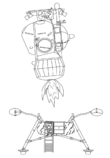
Zond (Soyuz 7K-L1) Lunar flyby missions Kosmos 146, Kosmos 154, Zond 1967A, Zond 1967B, Zond 4, Zond 1968A, Zond 1968B, Zond 5, Zond 6, Zond 1969A, Zond L1S-1, Zond L1S-2, Zond 7, Zond 8, Zond 9, Zond 10LK Lander (T2K) test missions Hardware Soviet and Russian government manned space programs Active Past Cancelled Categories:- 1969 in spaceflight
- 1969 in the Soviet Union
- 1971 in spaceflight
- 1971 in the Soviet Union
- Exploration of the Moon
- Lunar spacecraft
- Soviet lunar program
- Space launch vehicles of the Soviet Union
Wikimedia Foundation. 2010.


